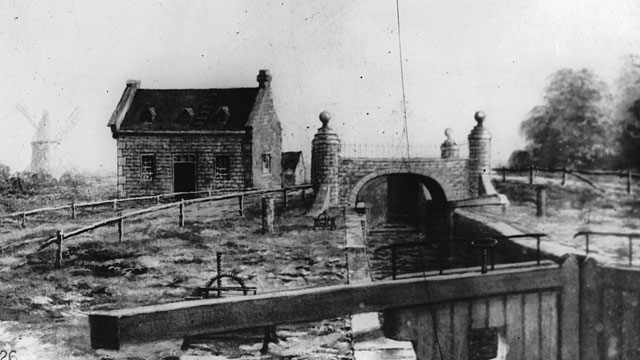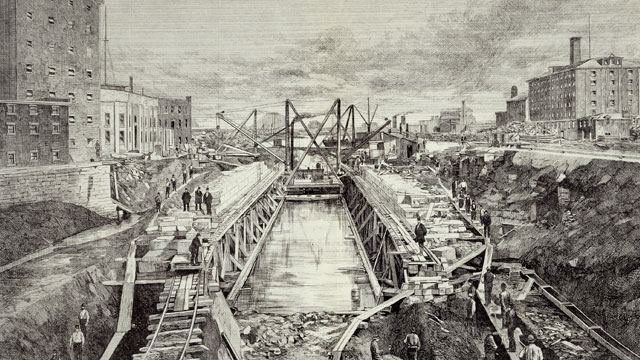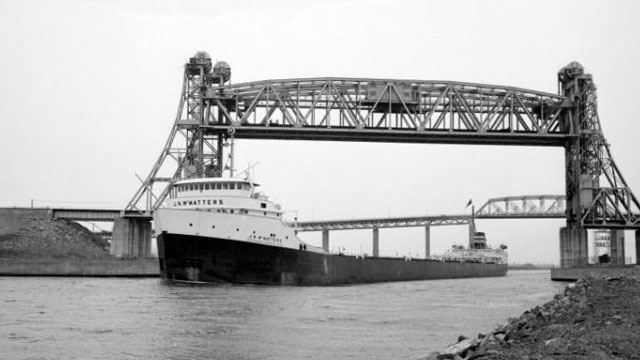
Entrance to the Lachine Canal in Montreal, circa 1850. © McCord Museum M984.273.
The first link in the canal network
Lachine Canal National Historic Site
A commercial necessity
In the period dominated by the fur trade, canoes and flat-bottomed "batteaux" ensured the link between the Montréal merchants and the fur-posts scattered across the continent. Then the demographic and economic context changed. After the American War of Independence, many Loyalists settled in what would become Upper Canada. Many British immigrants were added to this first wave of colonization. In the early 19th century, the exploitation of the province's agricultural potential and its supply of all kinds of goods would increase the commercial exchanges between Upper Canada, Lower Canada and Great Britain. Trade in wheat and wood would gradually replace that of fur.
On the other side of the border, the American Midwest was undergoing an even more marked period of expansion. However, the project to build the Erie Canal in New York State threatened to divert most of the Great Lakes trade towards the port of New York. The Montréal merchants were worried and wanted to strengthen their control over the Great Lakes business by attracting commercial traffic to their city. To this end, they had to improve navigation upstream from Montréal. Banding together to form the Company of the Proprietors of the Lachine Canal, they would instigate the construction of the first canal.
On July 17, 1821, John Richardson, a prosperous merchant and founder of the Bank of Montréal, would signal the beginning of the works that would be completed in 1825. A total of 7 locks stretched along the 14 km that separate the port of Montréal from Lake Saint-Louis. At the beginning, the canal was mainly used to transport merchandise.
A step towards maturity

The first canal enabled the passage of small ships. From 1825 to 1840, the number of ships on the canal increased sevenfold and the number of passengers increased fivefold. Due to this increase in traffic and the use of increasingly bigger ships, the widening of the canal became imperative only 20 years after it opened. It would not be until the end of the 1830-1840 decade, marked by economic and political crises in Upper and Lower Canada, that this work would be completed.
In 1840, the two provinces were reunited. London then initiated a vast, continuous canalization program between Montréal and Lake Erie, a project considered to be the keystone to Canadian prosperity. The canalization works were carried out from 1843 to 1848. The Lachine and Welland canals were widened and the number of locks on the Lachine Canal was reduced to five. The Beauharnois, Cornwall and Williamsburg canals were also built to bypass the rapids upstream from Saint-Louis and Saint-François lakes.
The Irish at the heart oof f the construction the Lachine Canal
Making up the majority of the workforce assigned to the construction of the Lachine Canal, the Irish settled in Griffintown. Beginning in 1845 and into the 1850’s, they flocked to Canada. For the most part they were penniless, forced out of their country by the Potato Famine.
With no skills, the only work they could get was that which gave them their reputation as “hard workers.” In North America, no canal or railway was built without them. In this same period in the United States, the "Canal Era" came to an end. Driven by unemployment, thousands of Irish migrated from the south to build the St. Lawrence canals.
Feats of hydraulic engineering performed with basic equipment
Having only their brawn to provide power, the Irish were at the heart of the construction of the Lachine Canal and its two subsequent expansions. Creating a navigable waterway requires digging a canal, building masonry locks, digging tunnels, and building drains, spillways, etc. These hydraulic engineering exploits were carried out with basic equipment: shovels, picks, pickaxes, buckets, augers, spades, and iron bars to dig put and split the rock; trowels, chisels, mallets, etc, for stone cutting; and axes, hammers, chisels, squares, etc. for making the lock gates.
As for the last expansion, while steam-powered excavators were used, a good part of the work was still accomplished by manpower. Working from dawn until dusk six days a week, rain or shine, these hard-working men dug a 15.5-km canal out of ground that was one third rock.
A canal worthy of a country

After Confederation in 1867, the government developed a "National Policy" based on interprovincial exchanges and the conquest of the West. Quebec and Ontario greatly benefited from this policy; they notably became important suppliers of manufactured products and had the transhipment ports for cereals from the prairies.
In 1872, following a board of inquiry on the role of the St. Lawrence waterway, Parliament decided to enlarge it. Work on the Lachine Canal began in 1873 and lasted until 1884. It was completed a few years later with the electrification of the lock door mechanisms.
Work on the entire St. Lawrence lasted about thirty years. With this new canalization network, which included the construction of the Soulanges Canal, ocean-going ships could now cross the 2100 km and the 163.6-m denivellation separating Montréal from Lake Superior.
Limited success

The canal continued to be a privileged industrial axis until 1950, but its efficiency as a shipping corridor diminished rapidly. A victim of its success, it was a prisoner of the urban and industrial development to which it had contributed. It could not be expanded a third time. Faced with the increasingly large size of ships, the canal had to give way to the St. Lawrence Seaway, cut on the south shore of the river. Eleven years after its opening in 1959, the canal was permanently closed to shipping.
- Date modified :